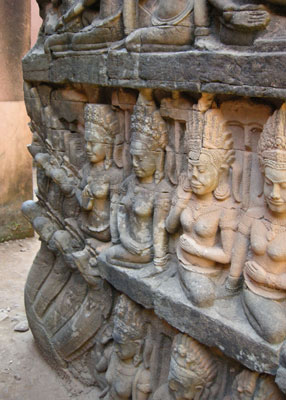Leper King Terrace
Almost all tour itineraries at Cambodia’s ancient Khmer capital, Angkor, include a stop at the Elephant Terrace. If you’re lucky, your guide may mention the Leper King Terrace located north and to your right as you face the Elephant Terrace. You’re even more fortunate if your guide mentions the narrow corridor excavated behind the facade of the Leper King Terrace. This corridor is concealed and not marked well, so it’s hard to find without having it pointed out to you.
This corridor can be entered along the side to your left as you face the terrace. Inside are wall reliefs that have been hidden for centuries.
I was privileged to view the terrace’s superb reliefs in 2005 and again during the “Cultural Treasures of Vietnam & Cambodia” tour with Vantage Deluxe World Travel (Boston, MA; 800/322-6677), Dec. 3-22, 2009.
The terrace dates from the late 12th century and was built in Angkor’s Bayon style. Its name is probably a misnomer; the statue sitting atop the terrace, a kneeling nude figure, had been identified as representing King Jayavarman VII (reputed as having leprosy), but archaeologists now believe the figure is that of Yama, the Hindu deity of the underworld.
Today, the statue at Angkor is only a replica. The original figure resides under its own canopy in the courtyard of the National Museum in Phnom Penh.
There is disagreement as to why the reliefs of the first facade were covered over when the terrace was expanded with the second facade. Both the inner and outer walls are decorated with similar subjects, including deities, kings, warriors, sea creatures and nagas (multiheaded serpents).
The carvings on the outer wall show many signs of weathering.
Excavated in the 1990s, the inner wall’s magnificently preserved reliefs can be viewed by entering the long, twisting and turning narrow corridor formed by the walls some six meters in height on either side. These masterworks of Khmer sculpture are some of Angkor’s finest and best preserved.
DAVID J. PATTEN
St. Petersburg, FL

